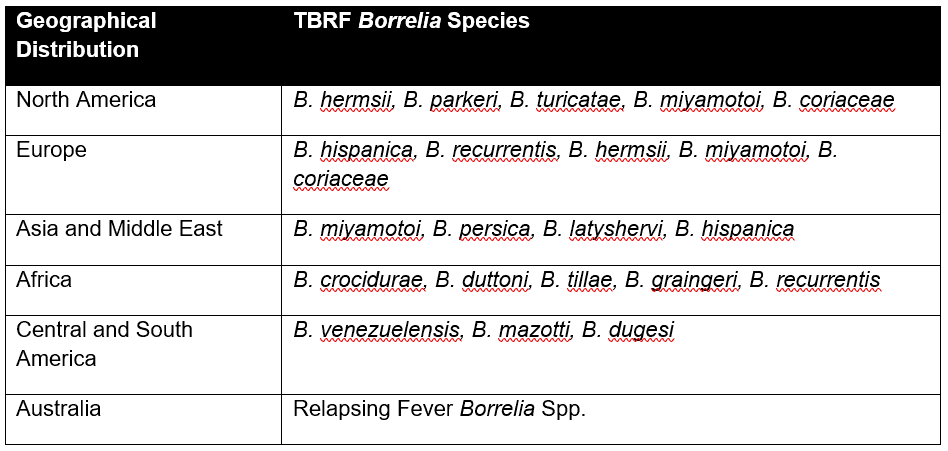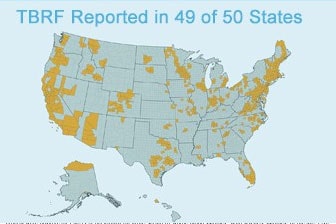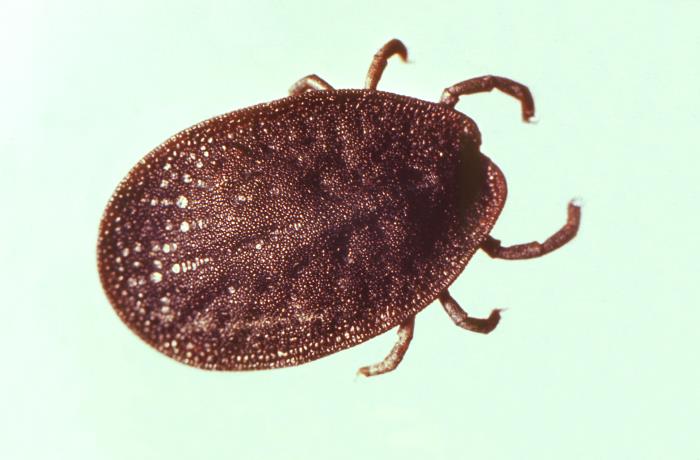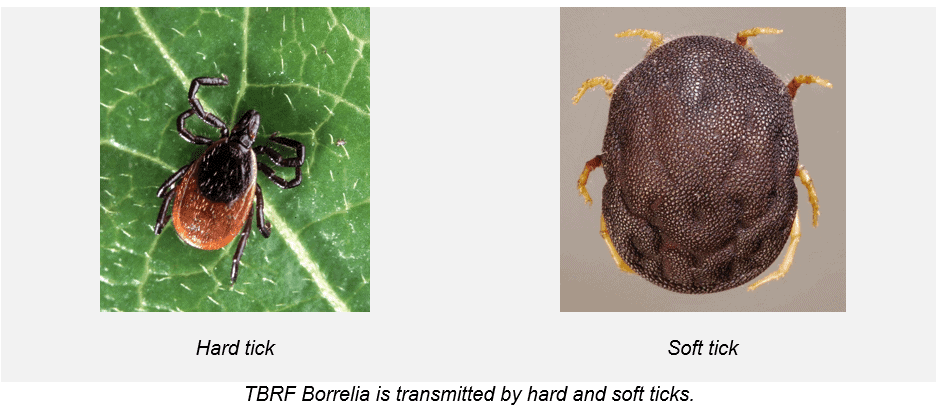As if diagnosing tick-borne diseases weren’t already hard enough, the spread of Tick-Borne Relapsing Fever – which can present similarly to Lyme but is caused by a different set of species of Borrelia – is adding to the challenge.
Once thought to be more prevalent in the western United States, Tick-Borne Relapsing Fever (TBRF) is becoming more common. Therefore, it’s more important than ever for people to be aware of what TBRF is and how it spreads. It’s also crucial for doctors to put TBRF on their radar when it comes to testing and diagnosis.
What You Should Know About Tick-Borne Relapsing Fever
1. TBRF is a bacterial infection caused by a group of species of Borrelia.
If you are familiar with Lyme disease, you may or may not be familiar with the name Borrelia, as Lyme is caused by several species (at least 18) of bacteria known as Borrelia burgdorferi. The bacteria that cause TBRF, by contrast, form a different group of Borrelia species. The two groups of Borrelia share some similarities – for example, all Borrelia are spirochetes, meaning spiral in shape – but cause distinct diseases and, as we will explain later in this article, are transmitted by different types of ticks.
More importantly, the types of Borrelia that cause TBRF will not be detected by a Lyme disease test, as Lyme tests are designed to detect only the types of Borrelia that cause Lyme. Since both diseases can cause similar symptoms, it is not uncommon for someone with TBRF to incorrectly believe they do not have a tick-borne disease after receiving negative results on a Lyme test. It’s important for patients and doctors to consider and test for TBRF when tick-borne disease symptoms are present.
Below is a list of TBRF Borrelia species from across the world.

2. Don’t let the name fool you!
The name Tick-Borne Relapsing Fever comes from one of the primary symptoms of the disease, which are recurring periods of high fever lasting about three days, followed by approximately seven days without fever, and so on.

Image Source: https://www.cdc.gov/relapsing-fever/symptoms/index.html
However, the absence of recurring fevers does not indicate the absence of a TBRF infection. Many doctors think, “My patient can’t have TBRF as he/she is not experiencing relapsing fevers.” The name can be misleading, because not all patients infected with TBRF Borrelia suffer from or recall having relapsing fevers.
3. There are two types of Relapsing Fever: Tick-Borne (TBRF) and Louse-Borne (LBRF).
As the name suggests, LBRF is transmitted not by ticks but by the body louse. However, LBRF is caused by a distinct species of bacteria – Borrelia recurrentis – and is usually associated with conditions of overcrowding or social upheaval, such as migrant crises or wars. Today, LBRF is mostly confined to sub-Saharan Africa.
TBRF, on the other hand, has a worldwide presence and continues to present a danger to the public, including Americans across the continent.
4. TBRF is NOT just a west coast disease.
Many people believe you can only get TBRF if you live west of the Mississippi, or if you sleep in rustic, rodent-infested cabins. While these are absolutely risk factors according to the Centers for Disease Control and Prevention (CDC), they don’t paint a full picture of the dangers of TBRF.
In reality, TBRF is present in all 50 states. That means you can get TBRF even if you live outside of California or other western states. In fact, the TBRF-causing bacteria discovered in hard ticks – B. miyamotoi, originally found in Japan – has also been found in the Eastern United States in recent years, in areas where Lyme is endemic.

IGeneX has found TBRF in 49 of 50 states. NY recently approved the tests. Therefore, no NY data available at present.
B. miyamotoi is important for several reasons. First, it marks an exception to the way TBRF is spread, which was previously through mostly soft ticks. (More on that later.)
Second, it presents some diagnostic problems for doctors because it is caused by a distinct bacterium and doesn’t always cause fevers – leading some to refer to it as B. miyamotoi disease rather than hard tick relapsing fever. However, doctors should take note of patients presenting with nonspecific or Lyme-like symptoms, even if they don’t live in soft tick endemic areas.
5. Unlike Lyme, TBRF is mostly spread by soft ticks.
Most cases of TBRF in the United States are spread by ticks in the genus Ornithodoros, also known as “soft ticks.” This is distinct from hard ticks in the family Ixodidae, which includes the species of deer ticks and dog ticks that transmit other tick-borne infections, such as Lyme disease, Rocky Mountain Spotted Fever, and more.
While hard ticks have a hard “shield” behind the mouthparts, soft ticks do not have this hard shield. Their bodies are shaped like raisins while hard ticks are shaped more like flat seeds when unfed (i.e., not “engorged”).
Soft ticks transmit several species of TBRF-causing bacteria, including B. hermsii, B. parkerii, and B. turicatae. B. hermsii is the most common causative agent of TBRF and is spread by the soft tick for which it is named, Ornithodoros hermsii. O. hermsii ticks are found in mountainous regions within the United States, typically at altitudes between 1,500 and 8,000 feet. They live within rodent burrows, including those of mice, squirrels and chipmunks. People most often encounter these ticks in rustic, rodent-infested cabins that are located at higher-altitude, coniferous forests.

Image Source: https://phil.cdc.gov/Details.aspx?pid=5970
Other species of soft ticks that transmit less common strains of TBRF-Borrelia are the O. parkeri ticks and the O. turicata ticks. These ticks are primarily found at lower elevations in the caves and burrows of ground squirrels, prairie dogs, and even burrowing owls.
It’s important to note that soft ticks don’t just spread different diseases than hard ticks, but they also behave differently. Rather than passively “questing” as the ticks that spread Lyme do, soft ticks hunt. At night, they will venture out from their host burrows to feed on other prey, including humans, as they sleep. Because their bites are typically painless, most people don’t even know they’ve been bitten when they wake up.
Finally, soft ticks can live longer than hard ticks (living several years rather than dying shortly after reproducing), and they feed for shorter periods of time – meaning it takes less time for them to transmit disease. In fact, soft ticks can transmit disease in as little as 15 minutes. This makes it more important than ever to educate yourself on proper tick check and tick removal procedures.
6. However, you can be infected by hard ticks too.
As discussed, the TBRF-causing B. miyamotoi has been discovered in two species of black-legged ticks in the United States – the Eastern black-legged tick, also known as the deer tick, and the Western black-legged tick. Note that these are the two tick species responsible for Lyme disease in the U.S., meaning hard tick Relapsing Fever is a risk in Lyme endemic areas on both coasts.

7. TBRF symptoms can look a lot like Lyme disease symptoms.
TBRF shares many of its most common symptoms with Lyme disease, including:
- Fever
- Chills
- Headache
- Muscle and joint aches
The most common symptom of TBRF is a high fever (e.g, 103 degrees F) that lasts three days, followed by seven days without fever, and so on in a recurring pattern. But TBRF – like Lyme – can present with nonspecific symptoms that make diagnosis difficult. As mentioned earlier, not all patients experience relapsing fevers.
If you have Lyme-like symptoms but have tested negative for Lyme disease, it’s important that your doctor considers testing for TBRF.
You may find the IGeneX symptom checker helpful in identifying your risk for TBRF.
8. Like Lyme, TBRF is treatable if caught in a timely manner.
Experts agree that TBRF can be successfully treated if caught early enough. Standard treatments consist of a seven- to ten-day regimen of antibiotics such as Tetracycline and Erythromycin. As with any infection, it is important to consult a physician immediately in order to be treated promptly.
Note: In a little more than half of all TBRF cases, patients develop a reaction to the drugs called a Jarisch-Herxheimer reaction. According to the National Center for Biotechnology Information, this reaction results in an acute exacerbation of a patient’s symptoms following the initial treatment of TBRF with an effective antibiotic. It typically begins within one to four hours of the first dose of antibiotics, and symptoms may include hypotension (low blood pressure), tachycardia (rapid heart rate), chills, rigor (tremors), and/or fever.
Treatment can take longer if a patient has a co-infection such as Lyme disease, Babesiosis or Bartonellosis. Mortality rates are very low for TBRF, but it can lead to complications if women are infected while pregnant.
9. Even if you don’t experience relapsing fevers or don’t remember a tick bite, you can still have TBRF.
While the most common symptom of TBRF is a recurring high fever – hence the name – fevers do not show up in all patients. Symptoms can often mimic those of other diseases, most commonly Lyme disease. Remember that many people also don’t notice or remember a tick bite but still become sick. Doctors should test for both soft and hard tick species of Borrelia to make sure they’re not missing a potential TBRF infection.
Preventing Tick Bites and Avoiding TBRF
One of the best ways to limit your risk for TBRF is to avoid sleeping in rodent-infested buildings whenever possible. Keep in mind that even if you don’t see rodent nests, other signs such as droppings can be a good indicator that a building is infested. Be sure to notify owners of vacation or rental properties of these signs if you find them. And if you own the property, consult with pest-control specialists to identify and address potential infestations and create an ongoing pest-control plan to mitigate future risk.
Also steer clear of other natural sites that may be infested with rodents, including animal burrows and caves. If you are in areas where tick populations are suspected, using repellent that contains DEET may help reduce your risk of tick contact.
IGeneX prides itself on offering tests that are more comprehensive and more accurate than the rest. To learn more about testing with IGeneX, find out how it works today.








